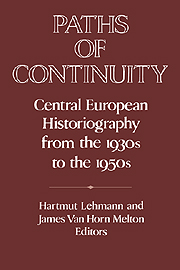Book contents
- Frontmatter
- Introduction: Continuities in German Historical Scholarship, 1933-1960
- 1 German Historiography from the 1930s to the 1950s
- 2 Friedrich Meinecke (1862-1954)
- 3 Change and Continuity in German Historiography from 1933 into the Early 1950s: Gerhard Ritter (1888-1967)
- 4 Hans Rothfels (1891-1976)
- 5 Franz Schnabel (1887-1966)
- 6 Heinrich Ritter von Srbik (1878-1951)
- 7 “Historical Social Science” and Political Myth: Hans Freyer (1887-1969) and the Genealogy of Social History in West Germany
- 8 Some Observations on the Work of Hermann Aubin (1885-1969)
- 9 From Folk History to Structural History: Otto Brunner (1898-1982) and the Radical-Conservative Roots of German Social History
- 10 Werner Conze (1910-1986): The Measure of History and the Historian's Measures
- 11 Continuity, Innovation, and Self-Reflection in Late Historicism: Theodor Schieder (1908-1984)
- Index
5 - Franz Schnabel (1887-1966)
Published online by Cambridge University Press: 05 January 2013
- Frontmatter
- Introduction: Continuities in German Historical Scholarship, 1933-1960
- 1 German Historiography from the 1930s to the 1950s
- 2 Friedrich Meinecke (1862-1954)
- 3 Change and Continuity in German Historiography from 1933 into the Early 1950s: Gerhard Ritter (1888-1967)
- 4 Hans Rothfels (1891-1976)
- 5 Franz Schnabel (1887-1966)
- 6 Heinrich Ritter von Srbik (1878-1951)
- 7 “Historical Social Science” and Political Myth: Hans Freyer (1887-1969) and the Genealogy of Social History in West Germany
- 8 Some Observations on the Work of Hermann Aubin (1885-1969)
- 9 From Folk History to Structural History: Otto Brunner (1898-1982) and the Radical-Conservative Roots of German Social History
- 10 Werner Conze (1910-1986): The Measure of History and the Historian's Measures
- 11 Continuity, Innovation, and Self-Reflection in Late Historicism: Theodor Schieder (1908-1984)
- Index
Summary
In the years following 1945, Franz Schnabel (1887-1966) exerted an exceptionally strong influence both on German historical scholarship and on a broader public interested in history. He did so through his German History in the Nineteenth Century (4 vols.), which now enjoys a broad reception in Germany, and through a series of articles, above all those on Bismarck and the creation of the Second Empire. In part his influence rested on wholly personal qualities: his rhetorical and literary talents, his keen capacity to make complex relationships comprehensible to the non-specialist, and the graphic and vivid way in which he was able to link the general and the particular. Moreover, among those historians who did not go into exile after 1933, Schnabel was one of the few who made no concessions to the Third Reich.
This includes those both of his own generation, who in 1945 were almost in their sixties, and those of the generation after him, who were by that time in their forties.
Schnabel paid a price for his liberal convictions and his unconditional commitment to democracy and the Weimar Republic, including dismissal from his Karlsruhe professorship, various forms of persecution, and in the end virtual isolation. But most importantly, Schnabel offered his readers and pupils an interpretation of Germanand European history that suppressed nothing and excused nothing. He did not interpret the Third Reich as a historical accident or unforeseeable “catastrophe.”
- Type
- Chapter
- Information
- Paths of ContinuityCentral European Historiography from the 1930s to the 1950s, pp. 155 - 170Publisher: Cambridge University PressPrint publication year: 1994



